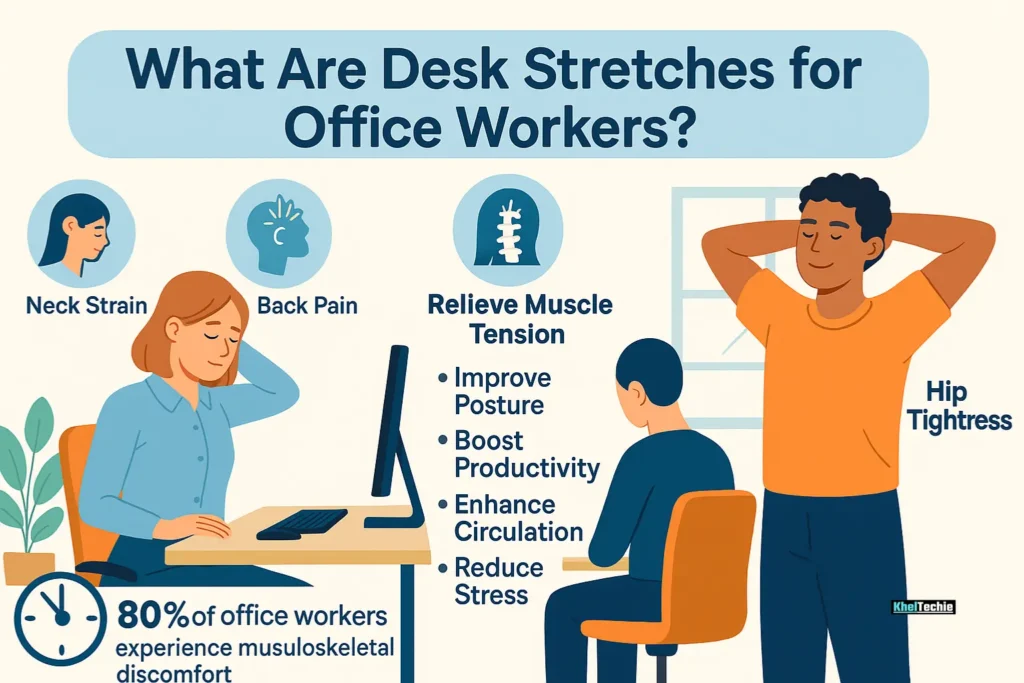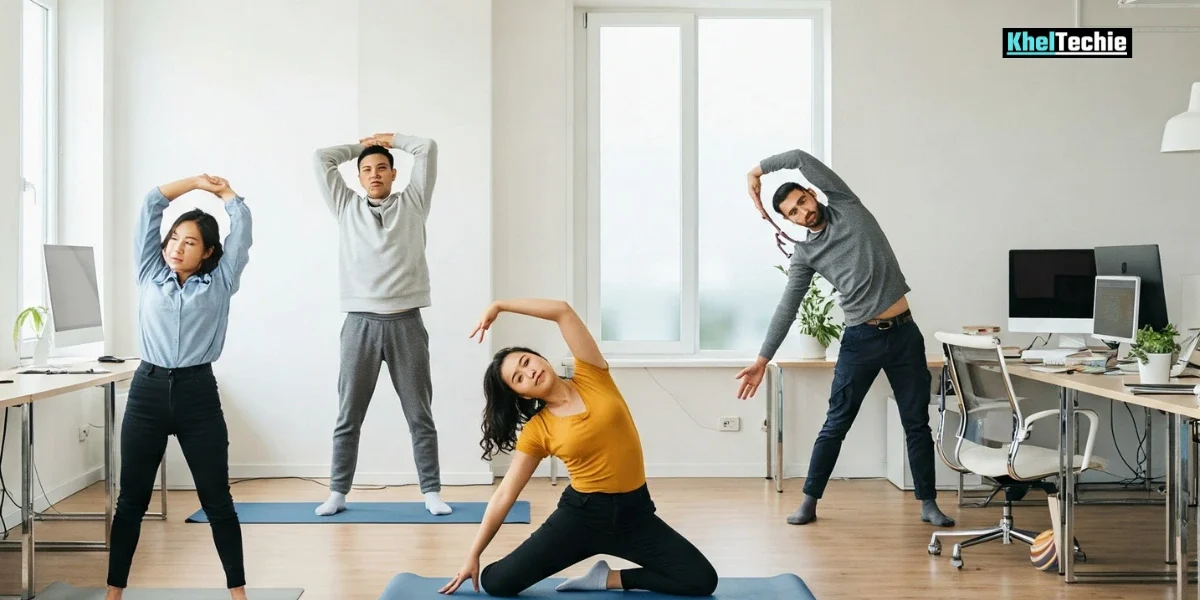Desk Stretches for Office Workers: To Slay Office Pain
Sitting for hours on end at a desk can wreak havoc on your body. From neck pain to back stiffness, office work can be taxing on your physical health. Luckily, incorporating desk stretches into your daily routine can help. In this guide, we’ll explore everything you need to know about desk stretches for office workers, why they matter, how to do them, and common mistakes to avoid.

What Are Desk Stretches for Office Workers?
Desk stretches are simple, low-impact exercises designed to alleviate muscle tension and improve flexibility for those who spend extended hours sitting. These stretches can be performed right at your workstation, requiring minimal space and no special equipment.
Think of your body as a car engine. Just like an engine needs regular maintenance to run smoothly, your body needs stretches to stay functional and pain-free. Without them, you risk “mechanical failures,” such as stiffness, pain, or even injury over time.
By incorporating these stretches into your routine, you can proactively combat the negative effects of prolonged sitting and maintain optimal health and comfort throughout your workday.
Why Do Desk Stretches Matter?
The Physical Toll of Sedentary Work
- Neck Strain: Prolonged screen time can cause tech neck, a modern-day ailment stemming from constantly looking down at devices.
- Back Pain: Poor posture and lack of movement lead to stiffness and long-term spinal issues.
- Wrist and Hand Discomfort: Typing continuously can result in repetitive strain injuries (RSI), such as carpal tunnel syndrome.
- Hip Tightness: Sitting compresses the hip flexors, leading to tightness and discomfort.
Benefits of Desk Stretches
- Relieve Muscle Tension: Stretching releases built-up stress in tight muscles.
- Improve Posture: Encourages proper alignment and reduces the risk of long-term complications.
- Boost Productivity: A quick stretch can reinvigorate you, improving focus and work efficiency.
- Enhance Circulation: Prevents blood pooling, reducing the risk of deep vein thrombosis (DVT).
- Reduce Stress: Movement encourages endorphin release, lifting your mood.
Stats
- According to a 2023 study by the American Chiropractic Association, 80% of office workers experience some form of musculoskeletal discomfort. Desk stretches can reduce this by up to 60%.
- A report by the Journal of Workplace Wellness highlights that regular stretching breaks can increase productivity by 12%.
Desk stretches matter because they serve as a simple yet powerful tool to counteract the challenges of sedentary lifestyles. Whether you aim to enhance your work performance, alleviate physical discomfort, or simply feel more energised, stretching can be a game-changer.

Step-by-Step Guide to Desk Stretches for Office Workers
1. Neck Stretches
Forward and Sideward Tilts
- Sit up straight.
- Slowly tilt your head forward, bringing your chin toward your chest.
- Hold for 10 seconds.
- Tilt your head to the right, bringing your ear toward your shoulder (don’t shrug).
- Hold for 10 seconds and repeat on the left side.
2. Shoulder Rolls
- Sit or stand comfortably.
- Roll your shoulders forward in a circular motion five times.
- Reverse the motion and roll backward five times.
3. Seated Spinal Twist
- Sit on your chair with your feet flat on the floor.
- Place your right hand on the backrest and your left hand on your right thigh.
- Twist your torso gently to the right, holding for 10 seconds.
- Repeat on the left side.
4. Wrist Flexor Stretch
- Extend your right arm straight out with your palm facing up.
- Use your left hand to gently pull your fingers back toward your body.
- Hold for 10 seconds and switch arms.
5. Seated Hamstring Stretch
- Sit on the edge of your chair.
- Extend your right leg straight out with your heel on the floor.
- Lean forward slightly, keeping your back straight.
- Hold for 10 seconds and switch legs.
6. Chest Opener
- Sit on the edge of your chair.
- Clasp your hands behind your back and straighten your arms.
- Lift your chest and gently pull your shoulders back.
- Hold for 10 seconds.
7. Ankle Rotations
- While seated, lift one foot slightly off the ground.
- Rotate your ankle clockwise five times, then counterclockwise.
- Repeat with the other foot.
These stretches can be easily incorporated into your day without disrupting your workflow. The key is consistency, aim to stretch every hour to maximise benefits.
Common Mistakes to Avoid
- Skipping Warm-ups: Even short stretches need a gentle warm-up to prevent strain. Simple wrist or shoulder rolls can suffice.
- Holding Breath: Always breathe deeply to enhance relaxation and oxygen flow to muscles.
- Overstretching: Stop at a point of mild tension, pain means you’re pushing too hard and risking injury.
- Inconsistent Routine: Stretches are effective only if done regularly. Set reminders to ensure you don’t skip sessions.
- Ignoring Ergonomics: Combine stretches with a well-designed workstation for optimal results. For example, adjust your chair height so your feet are flat on the floor.
Avoiding these common mistakes ensures that you derive the full benefits of desk stretching without risking injury or discomfort.
Conclusion
Desk stretches are a game-changer for office workers. Not only do they alleviate physical discomfort, but they also boost productivity and overall well-being. Start small, stay consistent, and consider investing in products like ErgoStretch Pro to maximise the benefits. Incorporating these practices into your daily routine can transform your workday experience.
Got a favourite desk stretch or tip? Share it in the comments below and help others thrive at work!
FAQs
How often should I do desk stretches?
Aim for 5-10 minutes of stretching every hour to counteract prolonged sitting.
Can desk stretches replace regular exercise?
No, they complement but do not replace cardiovascular and strength-training workouts.
Are desk stretches suitable for everyone?
Yes, but consult a doctor if you have pre-existing conditions or injuries.
What are the best stretches for neck pain?
Neck tilts, shoulder rolls, and chin tucks are particularly effective.
Can I do desk stretches while standing?
Absolutely! Incorporate standing stretches like side bends and calf raises.
How do I make stretching a habit?
Set reminders on your phone or calendar and involve colleagues for accountability.
Do I need special equipment for desk stretches?
No, most stretches can be done using just your chair and desk.
Are there apps for guided desk stretches?
Yes, apps like StretchIt and Office Yoga offer guided routines.
Can I stretch discreetly during meetings?
Yes, subtle stretches like ankle rotations or seated spinal twists can be done without drawing attention.
Are there risks to desk stretching?
Stretch responsibly and avoid overexertion. If discomfort persists, consult a healthcare professional.





Pingback: How To Improve Your Posture With Easy Exercises
Pingback: Beginner’s Guide To Yoga For Flexibility (Steps + Tips)
Pingback: Quick Healthy Lunch Ideas For Busy Professionals
Pingback: Desk To Dynamic: Quick Mobility Routines For Remote Workers